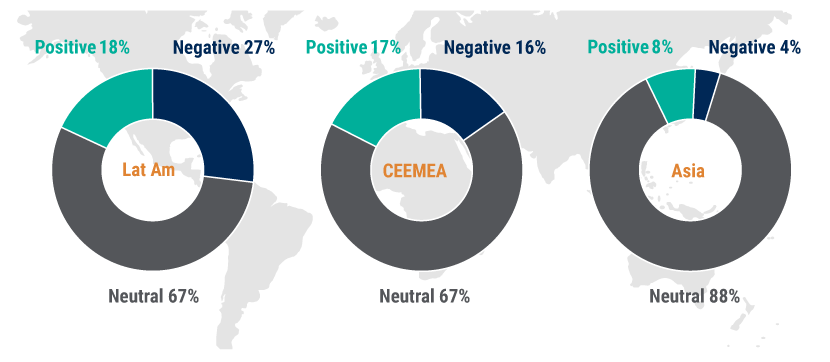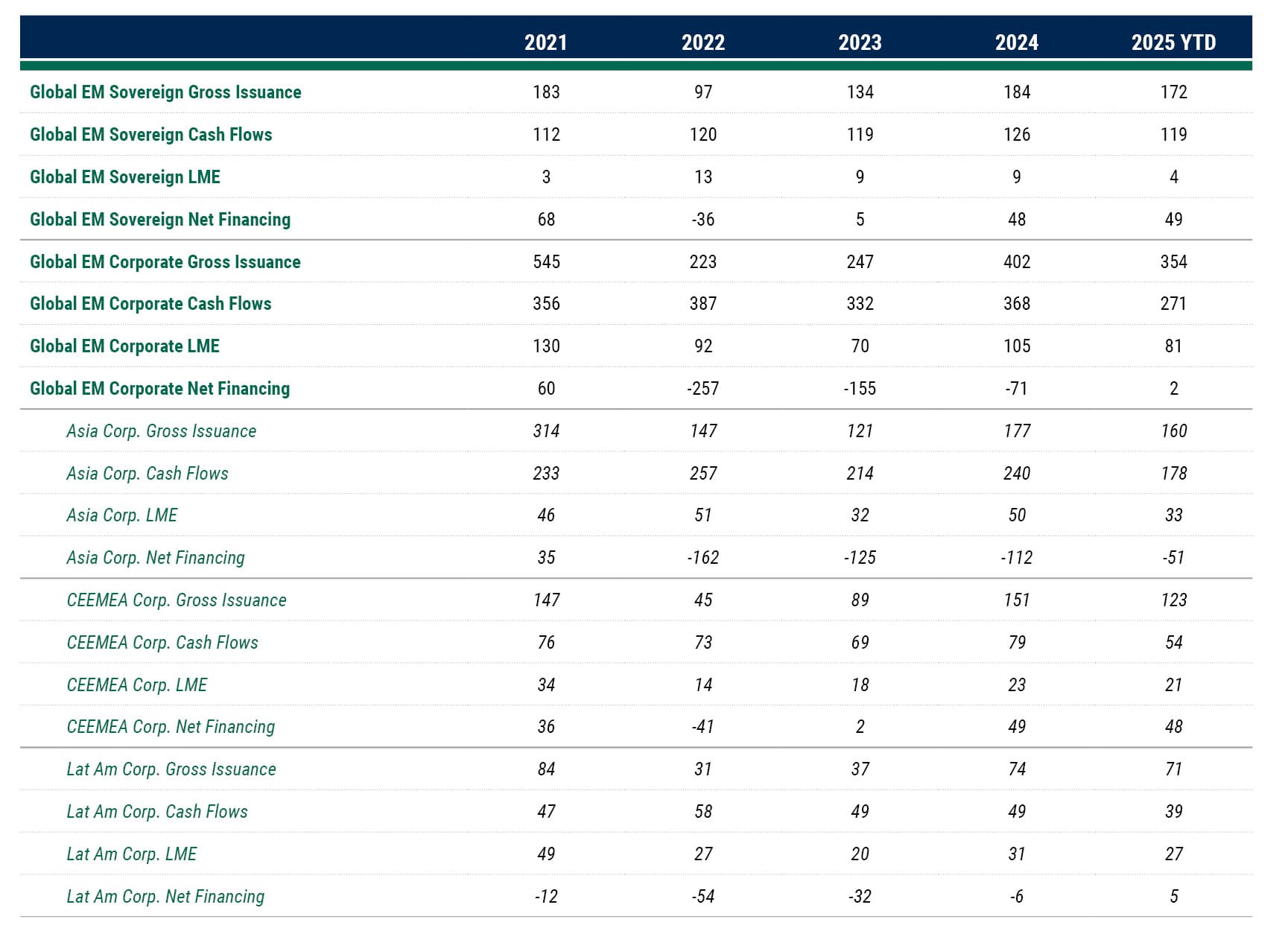EM Corporate Debt: A Compelling Option in Unsettled Markets

Jonathan Davis
Client Portfolio Manager and Sustainable Investment Strategist – Emerging Markets Fixed Income

Fan Zhang, CFA
Portfolio Manager & Credit Analyst, Fixed Income

Kathleen Monticello
Senior Vice President, Credit Analyst, Emerging Markets Fixed Income

Edward Iley
Senior Associate, Emerging Markets Corporates

Despite the economic and geopolitical uncertainty that has occupied headlines throughout the first nine months of 2025, financial markets are entering the final quarter of the year in much the same situation as when the year began. Asset prices continue to rise, making relative value opportunities scarce and punishing investors who forfeit carry returns as they wait for better entry points.
While credit might be expensive, with spreads near historical lows, yields remain high. Against this backdrop, we think investors should not shy away from credit risk, but rather look to diversify credit exposure. Much of the macroeconomic uncertainty now giving investors pause is emanating from the US, and we think global emerging market (EM) credit may prove resilient.
Global trade patterns are being redistributed, wars continue in Ukraine and the Middle East, and political risks – both domestic and international – threaten an already uncertain global economic outlook. Nevertheless, EM corporate earnings remain steady and are broadly in line with expectations across regions and sectors, supporting both the stable economic outlook that prevails throughout EM but also the fundamental creditworthiness of EM corporate issuers.
Second-Quarter 2025 Earnings Results vs. Expectations: EM Corporates by Region

As of 19 September 2025. Reflects performance of 2Q earnings for EM corporates under PineBridge coverage across Latin America, Central and Eastern Europe, the Middles East & Africa, and Asia. For illustrative purposes only. We are not soliciting or recommending any actions based on this material. Any opinions, projections, estimates, forecasts, and forward-looking statements presented herein are valid only as of the date of this presentation and are subject to change.
Asia withstands tariff headwinds
US tariffs are most directly aimed at Asia: Competition between the US and China for economic and technological supremacy impacts US imports from China and many other Asian economies, and trade within the region is adapting to subsequent changes in demand for various materials and goods. Nevertheless, second-quarter earnings results for the majority of Asia corporates were in line with expectations, with more earnings beats than misses across the region (see chart above).
The Macau gaming sector has been resilient, with events and concerts helping to boost revenue to post-pandemic highs and allowing issuers to keep reducing leverage. Following a tariff-related price drop in early April, industrial metals prices recovered throughout the quarter, while sales volumes remained elevated, contributing to a trend of better-than-expected earnings for the metals and mining sector, despite the underperformance of coal producers given the supply/demand imbalance. Asset monetization supported earnings within the telecom, media, and technology (TMT) sector, while AI-driven investments continued to bolster select names. Transportation companies continue to see positive earnings momentum from passenger traffic growth, while realization of M&A synergies for select issuers supported better-than-expected results.
LatAm earnings misses leaned more negative
While US tariffs are targeting imports from Asia, imports from Latin America are currently taxed at a much lower rate. However, Latin America does face its own set of macroeconomic challenges, notably a busy election calendar, volatile commodities prices, and an uncertain US economic outlook. These risks may be affecting the predictability of earnings, as just over half of Latin corporates delivered second-quarter earnings in line with expectations, generally lower than in other quarters.
Among the Latin corporates that did not meet expectations, more reported negative misses than positive beats. Lower oil prices dented revenues in the oil and gas sector, and unexpected work stoppages at several Colombian production sites also contributed to negative earnings results. While tariff uncertainty has not resulted in a substantial macroeconomic drag, it has had an impact on Latin America’s industrial sector, with weak demand for industrial products in the second quarter. Results also reflect the negative impacts of higher input costs for certain LatAm industrial companies.
CEEMEA results were balanced amid muted risks
Corporates in Central and Eastern Europe, the Middle East, and Africa (CEEMEA) are less directly affected by macroeconomic risks than their counterparts to the east and west. Earnings results for corporates in the region were largely in line with expectations, with roughly equal numbers of misses and beats.
While direct impacts of macroeconomic risks were limited, weak oil prices and higher production costs contributed to earnings misses for one-third of the region’s oil and gas names. Infrastructure companies, many of which operate ports, outperformed as shipping volumes remained high, due in large part to tariff frontloading, with only a marginal slowdown expected over the remainder of 2025. The real estate sector broadly beat expectations, as tourism and international demand remain strong in the region. Banks also beat expectations, supported by stronger loan growth and better-than-expected net interest margins.
Emerging market fundamentals look solid
Earnings results for companies across emerging markets affirm our view that fundamental risks remain relatively low. Global growth may trend lower, but that has not impaired companies’ ability to forecast revenues effectively and plan spending accordingly.
We continue to see, alongside resilient earnings, a general commitment to deleveraging across regions, which aligns with a long-term trend of conservative balance sheet management for EM corporates relative to their developed market peers. Furthermore, EM corporates have been actively managing liabilities, extending maturities, and enhancing their capital flexibility. As a result, it’s unlikely that an overextension of credit within the private sector will derail a stable economic outlook for emerging markets.
EM debt offers a compelling option for investors
Liability management among EM corporates provides an additional benefit to EM investors, boosting cash flows to levels that have consistently exceeded bond issuance since 2022. The resulting imbalance – greater cash flow than new bonds printed – provides technical support for bond prices. While issuance has increased this year, tenders, buybacks, and calls remain elevated, and inflows into the asset class continue to fuel strong demand for new bonds. Liability management is not as much a focus for sovereign issuers; however, cash flows are near historical highs, which, along with inflows into the asset class, continue to support market demand for what has been an active issuance calendar.
A Cash Flow/Issuance Imbalance Supports EM Bond Prices
EM hard currency bond issuance and net financing (US$ billion)

Source: JP Morgan and PineBridge Investments as of 9 September 2025. For illustrative purposes only. We are not soliciting or recommending any action based on this material. Any opinions, projections, estimates, forecasts, and forward-looking statements presented herein are valid only as of the date of this presentation and are subject to change.
Yields among US dollar credit markets remain elevated, driving global demand that is in turn pushing credit spreads tighter. Hard currency EM debt provides investors with a liquid credit market and historically attractive yield – a market in which tight spreads seem more rational relative to trading relationships and underlying risks.
Yes, EM spreads for both sovereign and corporate bond markets are tight. But the outlook calls for better economic fundamentals, including faster growth, stable account balances, and lower debt levels in emerging markets. And the strength of EM corporate credit dynamics – including resilient earnings, lower leverage, and supportive market technicals – makes for attractive comparisons with developed credit markets. All told, we believe EM hard currency debt is a compelling allocation for investors today.
Disclosure
Investing involves risk, including possible loss of principal. The information presented herein is for illustrative purposes only and should not be considered reflective of any particular security, strategy, or investment product. It represents a general assessment of the markets at a specific time and is not a guarantee of future performance results or market movement. This material does not constitute investment, financial, legal, tax, or other advice; investment research or a product of any research department; an offer to sell, or the solicitation of an offer to purchase any security or interest in a fund; or a recommendation for any investment product or strategy. PineBridge Investments is not soliciting or recommending any action based on information in this document. Any opinions, projections, or forward-looking statements expressed herein are solely those of the author, may differ from the views or opinions expressed by other areas of PineBridge Investments, and are only for general informational purposes as of the date indicated. Views may be based on third-party data that has not been independently verified. PineBridge Investments does not approve of or endorse any republication of this material. You are solely responsible for deciding whether any investment product or strategy is appropriate for you based upon your investment goals, financial situation and tolerance for risk.



